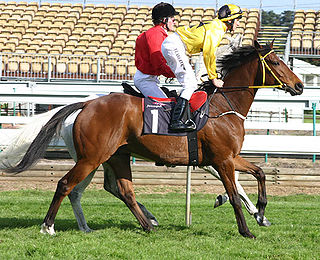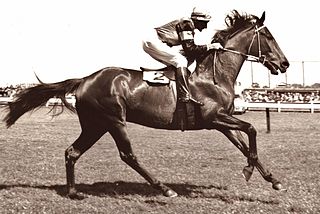About the Spring Grand Slam
The "Spring Grand Slam" in Melbourne is considered by some in the racing industry to be more difficult to win than the famous Triple Crown in the United States because the Australian races contain many more variables.
The Triple Crown — involving the Kentucky Derby, Preakness Stakes and Belmont Stakes — is contested only by three-year-olds who race over distances between 1910 metres (Preakness) and 2400 metres (Belmont). The horses all carry the same weight (fillies a little less than colts and geldings), and none of the horses are being asked to race around the track in an unaccustomed direction.
In Melbourne, the races are open to all horses aged three and over, and they race between 2,040 metres (Cox Plate) and 3,200 metres (Melbourne Cup).
The weight carried by horses can vary immensely, both in each race and from race to race, because three different handicapping systems are employed. The Caulfield Cup is a handicap race, the Cox Plate is a weight-for-age race, and the Melbourne Cup is a combination of both, a weight-for-age-handicap.
Furthermore, in the U.S., horses race counter-clockwise on all tracks, but in Australia and New Zealand, there are both clockwise and counter-clockwise tracks. All "Spring Grand Slam" races in Melbourne are raced counter-clockwise, so horses domiciled in areas with predominantly clockwise tracks can be disoriented and not perform to potential.

The Triple Crown of Thoroughbred Racing, often shortened to Triple Crown, is a series of horse races for three-year-old Thoroughbreds. Winning all three of these Thoroughbred horse races is considered the greatest accomplishment in Thoroughbred racing. The term originated in mid-19th-century England and nations where Thoroughbred racing is popular each have their own Triple Crown series.

The Belmont Stakes is an American Grade I stakes race for three-year-old Thoroughbreds run at Belmont Park in Elmont, New York. It is run over 1.5 miles. Colts and geldings carry a weight of 126 pounds (57 kg); fillies carry 121 pounds (55 kg). The race, nicknamed The Test of the Champion, The Test of Champions and The Run for the Carnations, is the traditional third and final leg of the Triple Crown. It is usually held on the first or second Saturday in June, five weeks after the Kentucky Derby and three weeks after the Preakness Stakes. The 1973 Belmont Stakes and Triple Crown winner Secretariat holds the track record of 2:24.

Thoroughbred racing is a sport and industry involving the racing of Thoroughbred horses. It is governed by different national bodies. There are two forms of the sport – flat racing and jump racing, the latter known as National Hunt racing in the UK and steeplechasing in the US. Jump racing can be further divided into hurdling and steeplechasing.

Thoroughbred horse racing is an important spectator sport in Australia, and gambling on horse races is a very popular pastime with A$14.3 billion wagered in 2009/10 with bookmakers and the Totalisator Agency Board (TAB). The two forms of Thoroughbred horseracing in Australia are flat racing, and races over fences or hurdles in Victoria and South Australia. Thoroughbred racing is the third most attended spectator sport in Australia, behind Australian rules football and rugby league, with almost two million admissions to 360 registered racecourses throughout Australia in 2009/10. Horseracing commenced soon after European settlement, and is now well-appointed with automatic totalizators, starting gates and photo finish cameras on nearly all Australian racecourses.

The W. S. Cox Plate is a Group 1 Thoroughbred horse race for horses aged three years old and over under Weight for age conditions, over a distance of 2040 metres, that is held by the Moonee Valley Racing Club at Moonee Valley Racecourse, Melbourne, Australia in late October. The race has a purse of A$5,000,000.
The Spring Racing Carnival is the name of an Australian Thoroughbred horse racing series held annually in Melbourne during October and November.

Northerly was an Australian racehorse who is considered arguably Australia's best middle distance Thoroughbred horse of the early 2000s. Northerly, trained by Western Australian harness racing legend Fred Kersley, won nine Group One (G1) races, including the Australian Cup twice, and the Cox Plate, regarded as the Weight for Age championship of Australasia, also on two occasions.

Lonhro was a champion Australian racehorse who is now standing at stud. Nicknamed "The Black Flash", he was from the first crop of the champion Octagonal out of the Group One-placed Shadea, who also produced the Group One winner Niello. Lonhro raced from two to five years of age and won 26 races, including 25 stakes races, ranging in distance from 1,100 to 2,000 metres. These included 11 Group One wins and 18 wins at weight-for-age. He was bred and owned by Woodlands Stud and trained by John Hawkes. Lonhro's name is based on the stock exchange code of the London Rhodesian Mining and Land Company, LONRHO. This arose from his foaling description as "tiny but perfect", a label ascribed to Roland "Tiny" Rowland, CEO of the company. The horse's name is deliberately misspelt.
Might and Power was a New Zealand bred, Australian owned and trained Thoroughbred racehorse who was named Australian Horse of the Year in 1998 and 1999. As a four-year-old, Might And Power won the Caulfield and Melbourne Cups, and returned at five to become only the second horse in the history of Australian racing to win both Cups and the Cox Plate. He also won a number of other weight-for-age races in this period, including the Mercedes Classic, the AJC Queen Elizabeth Stakes, and the Doomben Cup. A strong, free-striding front-runner, he broke course records in winning the Caulfield Cup, the Doomben Cup, and the Cox Plate, and won a number of races by big margins.

Rising Fast was a champion New Zealand-bred Thoroughbred racehorse who is the only horse to complete the Spring Grand Slam, winning the Melbourne Cup, Caulfield Cup, and Cox Plate in 1954. He also won the 1955 Caulfield Cup and came second in the 1955 Melbourne Cup.
Sunline was a champion New Zealand-bred Thoroughbred racehorse who was the world's highest earning race mare of her time. She won 32 of her 48 races with earnings of NZ$14,200,000. She was named the New Zealand Horse of the Year four times and Australian Horse of the Year three times. She has won the most Group races in modern times with 27, and she previously held the international record of 13 Group One wins until Melody Belle surpassed her in 2021.

Royal Gem was a versatile Thoroughbred racehorse that won 23 races ranging from 5 furlongs to 12 furlongs. He was later a successful sire in the United States.
The Livamol Spring Classic Formerly the Kelt Capital Stakes is a Weight-for-age Thoroughbred horse race run at Hastings Racecourse in Hawke's Bay and was at one stage New Zealand's richest horse race. It is run at a distance of 2040m and carries prize money of NZ$250,000.
The Race of the Century was the name given to a 1986 W. S. Cox Plate, a thoroughbred horse race in held in Melbourne, Australia, between two New Zealand racehorses of the 1980s.

In the United States, the Triple Crown of Thoroughbred Racing, commonly known as the Triple Crown, is a series of horse races for three-year-old Thoroughbreds, consisting of the Kentucky Derby, Preakness Stakes, and Belmont Stakes. The three races were inaugurated in different years, the last being the Kentucky Derby in 1875. The Triple Crown Trophy, commissioned in 1950 but awarded to all previous winners as well as those after 1950, is awarded to a horse who wins all three races and is thereafter designated as a Triple Crown winner. The races are traditionally run in May and early June of each year, although global events have resulted in schedule adjustments, such as in 1945 and 2020.

Tulloch was a champion Australian Thoroughbred racehorse who was one of the greatest Australian stayers.
The 2015 Breeders' Cup Classic was the 33rd running of the Breeders' Cup Classic, part of the 2015 Breeders' Cup World Thoroughbred Championships program. It was run on October 31, 2015 at Keeneland in Lexington, Kentucky.

The Grand Slam of Thoroughbred racing is an informal name for the winning of four major Thoroughbred horse races in one season in the United States. The term has been applied to at least two different configurations of races, both of which include all three races in the Triple Crown – the Kentucky Derby, Preakness Stakes and Belmont Stakes. The fourth race is either the Travers Stakes or the Breeders' Cup Classic.
The 1997 Melbourne Cup was a two-mile handicap horse race which took place on Tuesday, 4 November 1997. The race, run over 3,200 metres (1.988 mi), at Flemington Racecourse.











